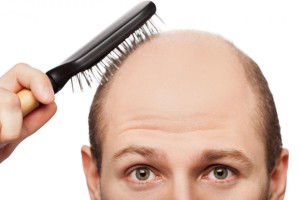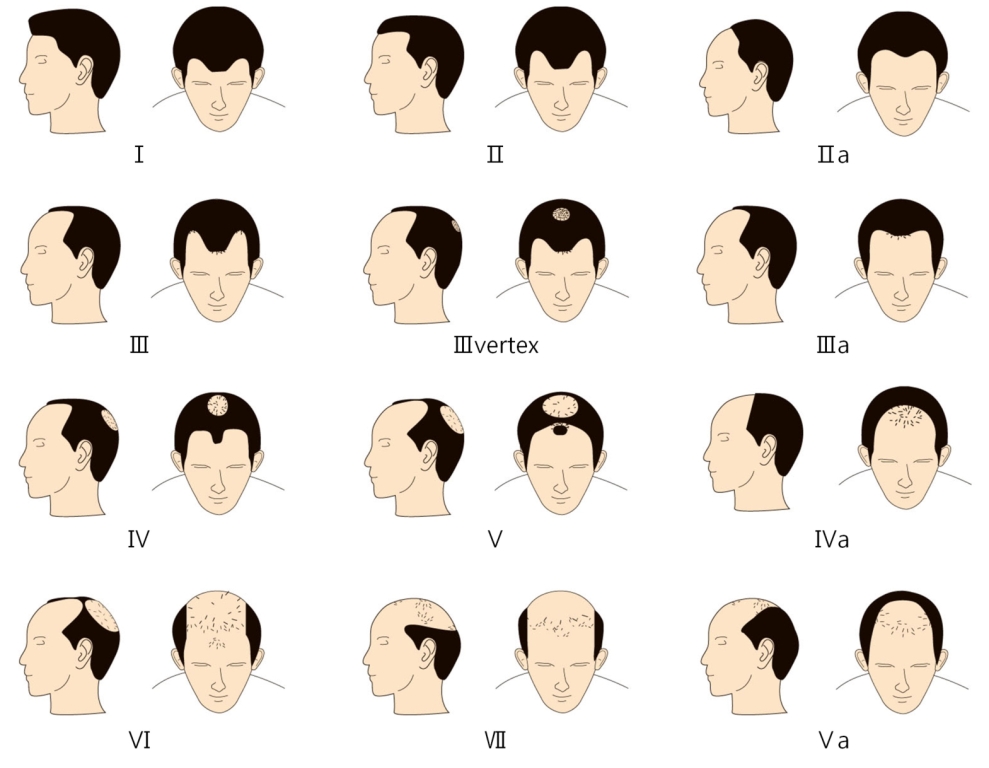IMPORTANT POINTS ABOUT MALE PATTERN BALDNESS
- AGA causes 95% of all hair loss in men, followed by Alopecia Areata (1-2%)
- AGA progresses with age
- AGA is unpredictable
- You may be the first one with AGA in family
- There is no actual loss of hair follicles
INCIDENCES OF AGA IN MEN

- About age 21, 25% of men with AGA first notice hair loss.
- About 25% by age 25-30 will have AGA.
- About 40% by age 40 will have AGA.
- About 50% by age 50 will have AGA.
GRADES OF MALE PATTERN BALDNESS

CAUSES OF MALE PATTERN BALDNESS
Hair loss can result from many factors. Some of these include thyroid disorders, high fever, diet, childbirth, and certain medications. The most common form of scalp hair loss is termed androgenetic alopecia (male and female pattern hair loss). This type of hairloss is not caused by poor circulation, clogged hair follicles, frequent shampooing, or the use of hats or helmets.
AGA is determined by a combination of hereditary factors and male hormones called androgens which include testosterone and dihydrotestosterone (DHT). The tendency for male and female pattern hair loss is genetically inherited from either side of the family and begins to develop after puberty. Hair on the scalp that is genetically affected by DHT (generally the front and top of the scalp), starts to shrink until it is lost. Whereas hair at the back and sides of the scalp is permanent because it is not affected by DHT as there are no recpetors on which dht can act so they are spared.
PATHOLOGY
The primary pathology is progressive miniaturization of scalp hair transforming to fine vellus hairs. Androgens, specifically dihydrotestosterone (DHT), cause miniaturization in men. Patients with AGA are inherited with hair follicles more sensitive to DHT.
Miniaturization is a complex multifactorial process driven by both genetic and non-genetic factors. Not every follicle is affected at the same time or to the same extent. Miniaturization can take place within a few years for some, or decades for others.
SIGNS AND SYMPTOMS
Increase the number of the miniaturized follicles causes baldness. Hair follicles in hairline, midscalp, crown, and temples are most sensitive to DHT. In men the first appearance is therefore a receding hairline and/or thinning crown. Thinning eventually progresses into other areas. Hair loss is gradual and progressive.
In the more advanced AGA only a rim or “horseshoe” pattern of hair remains. In some men even this remaining rim of hair can be affected by DHT.
PHYSICAL EXAMINATION
Presence of miniaturized hair follicles smaller than 0.02mm is an early marker of AGA even when a normal number of thick hairs is still present. In advance AGA the Terminal/vellus hair ratio change from the normal 8 : 1 to 4 : 1. The total number of hairs remains the same in 90% of cases.
PSYCHOLOGICAL IMPACTS OF AGA
AGA can adversely affect the social interaction and employment opportunity.
WHAT CAN BE DONE ABOUT AGA ?
People with thinning hair now have more options available to them than ever before. Hair restoration surgery offers a permanent, living solution to lost scalp hair. Moderately effective medical treatments are now offered in the form of a pill and a lotion. Cosmetic enhancers include colored creams, sprays, and powders that when applied to the thinning scalp help to camouflage thinning areas, as long as there is still some hair present in the area. Hairpieces and weaves are a non-surgical means to restore hair by covering bald areas of the scalp.
AGA AND FUE HAIR TRANSPLANT
- 70% of men of all age can consider hair transplant
- Virtually all with less than Class VII can expect good result
- No age limit for fue hair transplant as each case must be assessed individually
MEDICAL TREATMENT OF AGA
The miniaturization can be controlled or reversed:
- By addition of hair growth stimulator, or
- By DHT blocker
Only 2 FDA approved medications are available :
- Minoxidil in the form of topical application
- Finasteride in tablet form
Others which may be useful are :
- Ketoconazole Shampoo
- Biotin supplement
Success depends on early intervention and continuation of treatment. Once the hair diameter falls below 0.04mm, it cannot be rescued.





